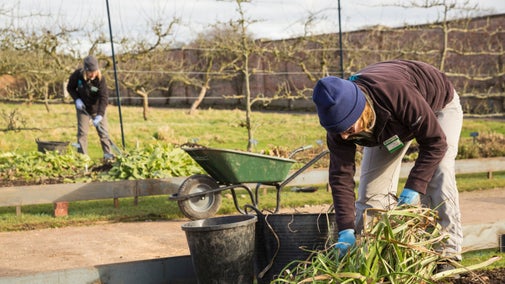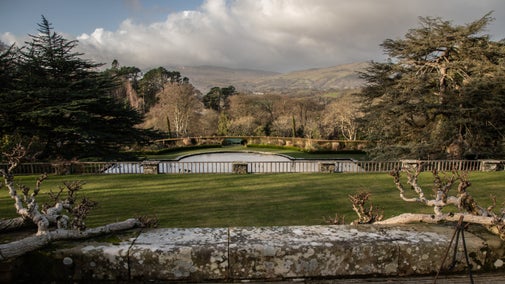
Discover more at Tintagel Old Post Office
Find out when Tintagel Old Post Office is open, how to get here, the things to see and do and more.

Find this tranquil garden hidden away from the busy high street. Have a wander and be inspired to plant something new in your own garden.
When the Old Post Office was first built Tintagel would have been a tiny farming hamlet. On the extreme North Cornish Coast which is regularly battered by Atlantic gales and can surprise us with harsh frosts, snow and cold gusts relatively late into the season.
Tintagel Old Post Office may be a bit different to other cottage gardens you have visited because of its geological make-up. One of our main building materials is slate, from nearby Cliff Quarry, that is slow to warm up and hides quite a few slugs and snails! The Cornish clay soil is also a bit of a challenge, as it too is cold, cracks in the dry and sticky when wet.
People often ask what was originally here and the truth is that we don’t know. Unlike many of the National Trust’s other gardens there were no written accounts, records or plant lists that come with the garden. However we can have a good speculation at how this space would have been used and by whom throughout its centuries of habitation.
To begin with, for most of its use the garden area would have been utilitarian. It would have been where residents got their water from the well, kept some animals; some chickens, a few ducks, a pig or two and perhaps a milk cow in the area behind that back wall and some livestock in the fields that stretched down to the river. The garden would have been where they disposed of waste, went to the toilet during the day and emptied the chamber pots at night.
It may also have been where the lady of the house grew useful herbs and a few vegetables to help eke out and flavour what could be foraged, bought and grown. As well as plants for medicines and household sundries, like dyes and cleaning products. In this sort of household garden tasks would have been the job of the mistress and her daughters with the male residents tending to the farm or out working.
The herbs and plants that were in the garden, may have been foraged or shared between neighbours, friends and relatives along with recipes and tips of how to use them.
To help with the sweet-tooths in the family and the brewing of beer, a skep beehive or two would probably have been kept in the garden. A skep is at its most basic a home-woven upturned basket that the bees would make their comb inside. When it came time to harvest the honey, the comb would have been broken away and the contents eaten, wax and all. It’s also likely that some native bee-friendly wildflowers would have been planted to feed the bees too.
The garden that you see today is an altogether more decorative affair. It has been laid out in a Victorian cottage garden style. This style was chosen as the building’s local name has been, The Old Post Office, for over 100 years and refers to a period in the late 19th century when it served the community as a letter receiving office. This name has become as crucial to its identity as the wiggly roof. Because of this and its small size the National Trust decided to anchor the garden to its Victorian identity by creating a Victorian cottage garden.
The Old Post Office garden is romantic to its core, small in scale, cosy and protected from the unpredictable weather by hedges and walls. It also has a tranquil feel in contrast to the busy high street of Tintagel that has drawn visitors since the Victorian era.
Cottage gardens are adored because they have a quirky and informal charm. A regular layout with a central path that leads to the back door is contrasted with dense planting, abundant borders and plants that are allowed to self-seed and spill across pathways.
The borders and pots are continually changing with old-fashioned cottage plants, many of which have been popular for centuries. We do not keep strictly to a year when choosing plants, as we have no original drawings or records, any year we imposed would be false. However when new plants are chosen we are mindful that they should be reflective of the spirit of the Old Post Office

The garden is planted to actively encourage wildlife. The seasonal variety of the garden provides nectar and pollen for insects and nesting material for birds.
Butterflies, bees and bats are regular visitors and there are also visits from rabbits and moles. The compost area provides an ideal environment for slow-worms to nest and lay their eggs.

Hi, I'm Kate. I usually tend to the garden on Wednesdays, but as well as potting plants, mowing lawns, twiming edges and looking after what we've got, I'm also on hand to answer any questions you may have about the garden - so please feel free to come and have a chat with me.

Picnics are allowed and you are welcome to bring pasties, ice-creams and the like from the many food outlets in the village into the back garden. The lawn is a real sun trap and a nice place to relax, with one of Cornwall's oldest houses as the backdrop to your lunch!
Unfortunately we cannot allow any animals other than assistance dogs into the house or garden.


Find out when Tintagel Old Post Office is open, how to get here, the things to see and do and more.
The five rooms and cottage garden beckon the curious to explore over six hundred years of Cornish domestic life.

A story spanning six centuries, discover how this ancient abode went from being a thatched farm building in the Middle Ages, to a fashionable home in Tudor times before eventually becoming the letter-receiving office for the village in the 1870s.

Enjoy a picnic in the garden among sunny lawns and fragrant flowers, then visit the post-room shop to browse second-hand books and postcards.

Groups can uncover 600 years of history at Tintagel Old Post Office, with prior notice and booking.

This miniature medieval manor house, which is more than 600 years old, needs constant care and attention. National Trust specialists have worked hard to preserve Tintagel Old Post Office.

Discover our gardeners’ top tips so you can make the most of your garden, plot or window box.

From 18th-century water gardens and Arts and Crafts landscapes to intimate woodland gardens, there are so many places to discover.

Cornwall is not only home to dramatic coastline and countryside, but also a number of beautiful and historic gardens and parks. Discover colour and interest at hidden gems across Cornwall with your family.
